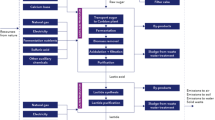Abstract
The sugarcane industry in Brazil is experiencing a rapid shift towards creating the grounds for a green and sustainable biorefinary industry. After 30 years of ProAlcool, the federal government program that boosted Brazil’s sugarcane industry by creating a mandate to blend ethanol with gasoline, flex fuel engines now dominate Brazil’s automobile industry. Currently, bioethanol replaces around 30% of the gasoline consumed in the country and its demand is projected to more that double in the next 10 years. On another front, the sugarcane genomics program created by FAPESP in the late 1990s paved the way for the establishment of innovative biotechnology startup companies that attracted the attention of the largest agro-biotechnology sector companies of the world. Almost all of these companies now have their sugarcane research centers surrounding the city of Campinas, São Paulo. In addition, innovative synthetic biology companies are developing technologies to produce diesel, jet fuel and other high value molecules using sugarcane juice as a carbon source. The sugarcane industry also teamed with petrochemical companies and already established operating plants to produce bioplastics. Innovations have also occurred in the field of co-generation of electricity from sugarcane bagasse. Currently sugarcane supplies 4% of the electricity needs of the country. Collectively, these innovations suggest that Brazil’s sugarcane industry could supply over 30% of the country energy needs by 2021 and a significant fraction of new bioproducts produced by its nascent biorefinary plants.



Similar content being viewed by others
References
Andrietta MGS, Andrietta SR, Steckelberg C, Stupiello ENA (2007) Bioethanol-Brazil, 30 years of Proalcool. Int Sugar J 109:195–200
Arruda P (2001) Sugarcane transcriptome. A landmark in plant genomics in the tropics. Genet Mol Biol 24
da Silva JAG, Bressiani JA (2005) Sucrose synthase molecular marker associated with sugar content in elite sugarcane progeny. Genet Mol Biol 28:294–298
Falco MC, Tullman Neto A, Ulian EC (2000) Transformation and expression of a gene for herbicide resistance in a Brazilian sugarcane. Plant Cell Rep 19:1188–1194
Garcia AAF, Kido EA, Meza AN, Souza HMB, Pinto LR, Pastina MM, Leite CS, da Silva JAG, Ulian EC, Figueira A, Souza AP (2006) Development of an integrated genetic map of a sugarcane (Saccharum spp.) commercial cross, based on a maximum-likelihood approach for estimation of linkage and linkage phases. Theor Appl Genet 112:298–314
Goldemberg J (2008) The Brazilian biofuels industry. Biotechnol Biofuels 1:1–7
Goldemberg J, Coelho ST, Guardabassi P (2008) The sustainability of ethanol production from sugarcane. Energy Policy 36:2086–2097
Greco A (2003) From bench to boardroom: promoting brazilian biotech. Science 300:1366–1367
Grushkin D (2011) Breaken the mold. Nat Biotechnol 29:16–18
Jank MS (2008) Cane for sugar, ethanol and bioelectricity: a global economy. UNICA, the Brazilian Sugarcane Industry. http://www.unica.com.br Cited
Lima MLA, Garcia AAF, Oliveira KM, Matsuoka S, Arizono H, de Souza CL, de Souza AP (2002) Analysis of genetic similarity detected by AFLP and coefficient of parentage among genotypes of sugar cane (Saccharum spp.). Theor Appl Genet 104:30–38
Macedo IC, Seabra EA (2008) Mitigation of GHG emissions using sugarcane bioethanol. In: Zuurbier P, van den Vooren J (eds) Sugarcane ethanol: contribution to climate change mitigation and the environment. Wageningen Academic Publishers, The Netherlands, pp 95–111
Matsuoka S, Ferro JA, Arruda P (2009) The Brazilian experience of sugarcane ethanol industry. In Vitro Cell Dev Biol Plant 45:372–381
Oliveira KM, Pinto LR, Marconi TG, Margarido GRA, Pastina MM, Teixeira LHM, Figueira AV, Ulian EC, Garcia AAF, Souza AP (2007) Functional integrated genetic linkage map based on EST-markers for a sugarcane (Saccharum spp.) commercial cross. Mol Breed 20:189–208
Sheridan C (2009) Making green. Nat Biotechnol 27:1074–1076
Vettore AL, da Silva FR, Kemper EL et al (2003) Analysis and functional annotation of an expressed sequence tag collection for tropical crop sugarcane. Genome Res 13:2725–2735
Waltz E (2010) Shell’s billions to convert Brazilian biomass into fuel. Nat Biotechnol 28:305–305
Author information
Authors and Affiliations
Corresponding author
Additional information
Communicated by: Paul Moore
Rights and permissions
About this article
Cite this article
Arruda, P. Perspective of the Sugarcane Industry in Brazil. Tropical Plant Biol. 4, 3–8 (2011). https://doi.org/10.1007/s12042-011-9074-5
Received:
Accepted:
Published:
Issue Date:
DOI: https://doi.org/10.1007/s12042-011-9074-5




